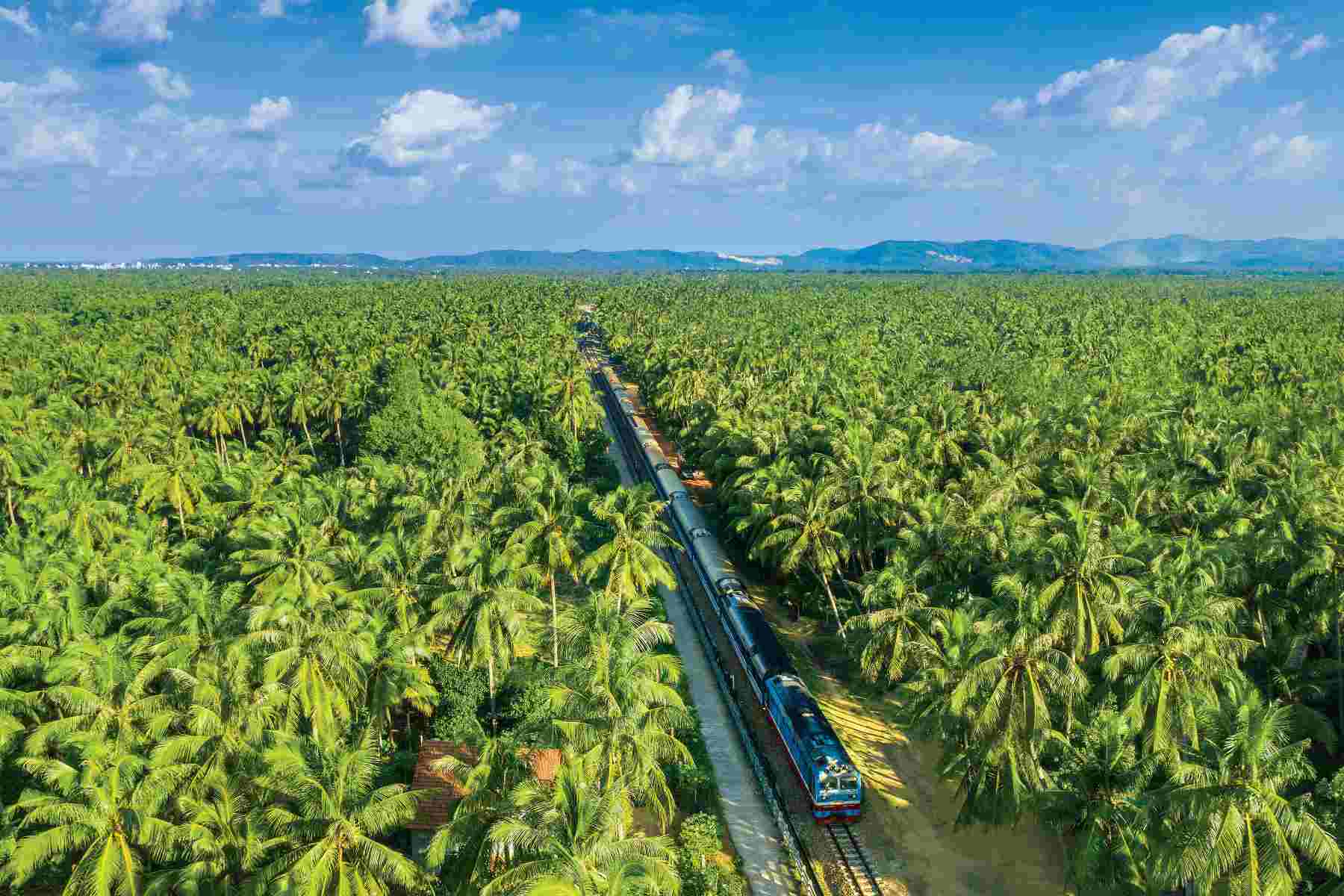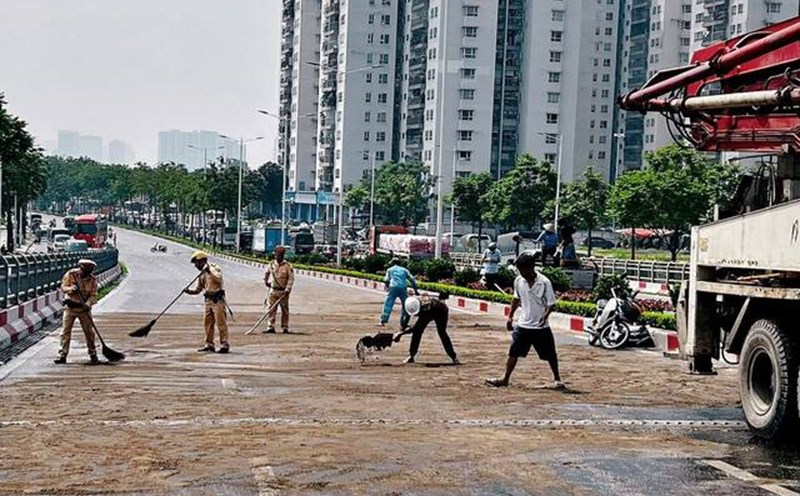Railway needs more space for development
There are no official statistics yet, but with more than 100,000 tickets sold just during the 30/4 holiday, the railway industry is expected to have a record revenue compared to the same period in previous years. This shows the role of railways in transportation development in Vietnam today.
From May 10, for the first time, Vietnam railway put into operation a 34-seat VIP car on the Hanoi - Hai Phong route. Most notably is the 34-seat VIP car with a interior designed in the Indochina style, combining modern features and traditional Asian colors towards elegance and nobility. On the new train cars, there are also automatic doors, electrical panels that display the location and speed of the train; spacious hand washing area, modern and airy toilets...
The VIP train and VIP train car model was once deployed on the Hanoi - Da Nang route. And in July 2025, the railway industry will celebrate the 140th anniversary of the first railway line in Vietnam being launched. That is the Saigon - My Tho route, 70km long.
After about that year, Vietnam's railways need more space for development. The speed of railways is also a limitation of the development of the industry. Another reason is that the railway industry itself has been locked up in the subsidy space for too long.
Conclusion No. 49-KL/TW dated February 28, 2023 of the Politburo on the orientation for the development of Vietnam's railway transport has determined: "Complete the legal system, mechanisms, preferential policies, create a favorable environment, encourage economic sectors to participate in investing in the development of railway transport... Research and promulgate appropriate mechanisms, policies, and solutions to remove obstacles and speed up the investment process of national railway and urban railway lines".

Unlocking resources
According to the Ministry of Construction, at the planning of the railway network period 2021-2030, with a vision to 2050, the Prime Minister approved the planning of provinces and cities, which determined the goal by 2030 to develop the urban railway system in centers of the province and big cities such as Hai Phong, Da Nang, Binh Duong, Can Tho ... Particularly in Hanoi, Ho Chi Minh City, and Ho Chi Minh City must basically complete the urban railway network in 2035.
However, the recent practice of investing in the construction of national railway and urban railway projects has shown that there are still many difficulties and problems focusing on key issues such as: Resource mobilization; investment procedures; implementation of planning; site clearance; human resource training, technology transfer, railway industry development...
To continue implementing railway projects according to the plan (Hanoi - Dong Dang, Hai Phong - Ha Long - Mong Cai, Ho Chi Minh City - Can Tho, Bien Hoa - Vung Tau, Thu Thiem - Long Thanh, Suoi Tien - Thu Dau Mot...) to meet the progress requirements as directed by the Party and Government leaders, it is necessary to have specific, special, and outstanding mechanisms and policies similar to the mechanisms and policies that have been allowed by the National Assembly to be applied to railway projects.
The Ministry of Construction believes that the development and promulgation of specific mechanisms and policies, especially to be applied generally to investment in the construction of railway projects, is very necessary and urgent to remove institutional "bottlenecks" and realize the investment goal of completing the national railway network and urban railways according to the plan.
Calculation of the Ministry of Construction, funding for investment and implementation of national railway projects is about VND 2,257,041 billion. Funding for investment and implementation of projects with the expected total investment capital demand for urban railway system of Hanoi and Ho Chi Minh City is about 3,247,852 billion VND, of which, the central budget supports the target for the two cities of about 509,602 billion VND, Hanoi City Budget balances the layout of about 1,170,250 billion VND, Ho Chi Minh City budget balances about 1,568,000 billion VND.
Many new points in the draft Resolution on piloting a number of specific mechanisms and policies, especially to invest in the development of the railway system. For the selection of contractors, investors, and investment decision-making authorities, the application of the form of bidding designation for the selection of consulting, non-consulting, goods, construction and installation contractors, EPC, EC, EP, hand-to-hand keys, and investors is decided.
Notably, organizations and individuals participating in scientific and technological activities serving the project are subject to policies such as: Deciding on limited bidding, appointing bids, placing orders to select contractors to provide services and goods; Enterprises are entitled to incentives such as high-tech enterprises according to the provisions of law on high technology during the implementation of scientific and technological tasks serving the project; Exemption from corporate income tax, exemption from personal income tax from performing scientific and technological tasks serving the project.
In particular, in the course of implementation, the heads of agencies, units, cadres, civil servants and officials participating in the project are considered to eliminate, exempt and reduce liability in accordance with the Party's regulations and the provisions of the law in the following cases: Acts are determined by the competent authority to dare to think, dare to do, dare to take responsibility for the common interest; Must obey the decisions of the superiors and have reported to the decision maker before the compliance; To implement the proposal on innovation, creativity and solutions to accelerate the implementation of the project authorized by the competent authority and in accordance with the policy of the competent authority, the motivation is clear, for the common interest.
Determining the start of construction of two important railway lines
At the meeting of the Steering Committee of key projects and important projects in the railway field, on the morning of April 26, the Politburo member, the Prime Minister Pham Minh Chinh - Head of the Steering Committee - Request, continue to focus on synchronously implementing high -speed rail projects in the North - South railway, Lao Cai - Hanoi - Hai Phong railway, railways in Hanoi and Ho Chi Minh City. The spirit is to have to implement the immediate work and to implement long -term work, build, improve institutions, mechanisms, policies, human resource training ...
The Prime Minister stated that the unchanged goal is to start the Lao Cai - Hanoi - Hai Phong project in 2025 and the North - South high-speed railway in 2026.
Regarding capital, the Prime Minister directed the mobilization of diverse capital sources, including self-made capital from the central and local governments, loans, bond issuance of the Government and enterprises, public-private partnership, etc.
Regarding legality, the Prime Minister assigned the Ministry of Construction and the Ministry of Justice to urgently complete the Resolution on unifying specific mechanisms for all railway projects, submitting to the Government in April and submitting to the National Assembly before May 5.
Restarting investment in Hanoi - Quang Ninh railway line
On April 29, the Ministry of Construction sent a document to the Railway Project Management Board regarding investment in the Hanoi - Quang Ninh railway line (Yen Vien - Pha Lai - Ha Long - Cai Lan). The Ministry requested this unit to review the investment plan for the above railway line.
The Ministry assigned the Railway Project Management Board to study and evaluate Vingroup Corporation's proposal on investment in the Hanoi - Quang Ninh railway line and the possibility of combining investment with the Yen Vien - Pha Lai - Ha Long - Cai Lan railway line to make the most of the invested works and items. Research and evaluate additional investment scenarios with speeds of 160km/h and 300km/h to propose effective investment scenarios; propose investment methods and solutions for accompanying mechanisms and policies.
According to the design, this new railway line uses a cage (including a track of 1.435m and 1m) using a seamless welding track, with a modern signal information system and intersections at different levels with national highways to reach a speed of 120km/h for passenger ships and 80km/h for cargo ships. If this route is completed, the passenger train journey from Ha Long to Yen Vien will be 1.5 - 2 hours; freight trains will be 3 - 4 hours.
Linh Anh








